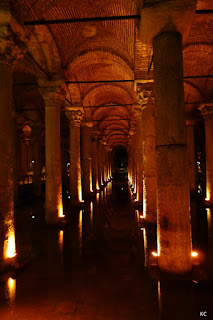02 Jun - Having done with the "Cotton Castle" of Turkey, enjoying the natural calcium carbonated water in the hope that it will have a smoothing effect to our skin, it was time to bid goodbye to Pamukkale. We woke up early in the morning again to catch our flight back to Istanbul. This time, we had the time to take a proper photo of the plane we are embarking.
Turkish Airline plane taking us back to Istanbul
Istanbul can be said to be at the crossroad between Europe and Asia. Wars has been fought in the past over the control of this land, contributing to its rich culture and history. In the area of religion, Istanbul was also instrumental in the advancement of Christianity during Roman and Byzantine times, before the Ottomans conquered the city in 1453 and transformed it into an Islamic stronghold and the seat of the Ottoman Caliphatem.
Safely landed to welcome the hot weather of Istanbul
The main mode of transport in Istanbul is trams
Beautiful park and nature to rest your soul during your rest time
A toilet in disguise, but with a gantry?
First peek of Hagia Sophia
Hagia Sophia has an interesting history. It is a former Christian patriarchal basilica (church), later an imperial mosque, and now a museum (Ayasofya Müzesi) in Istanbul, Turkey. From the date of its construction in 537 until 1453, it served as an Eastern Orthodox cathedral and seat of the Patriarchate of Constantinople, except between 1204 and 1261, when it was converted to a Roman Catholic cathedral under the Latin Empire. The building was a mosque from 29 May 1453 until 1931. It was then secularized and opened as a museum on 1 February 1935 (Wikipedia, 2015).
Gold painted interior
The hallway of Hagia Sophia
The interior of Hagia Sophia
The place of the coronation ceremony of the Eastern Roman Emperor
A unique structure displaying both Islamic and Christian traits together
Islamic designs painted over Christian crosses, showing the past history of Hagia Sophia as a church in the past before converting to a mosque.
Hagia Sophia in full view
Blue Mosque
Interior of the blue mosque
Beautifully decorated Islamic designs
After touring the Blue Mosque, we moved on to visit the Basilica Cistern, which has the capacity to store 100,000 tons of water, though not more than a few feet of water remains currently.
Source:
Wikipedia. (2015). Retrieved 22-Jul-2015 from https://en.wikipedia.org/wiki/Hagia_Sophia



















No comments:
Post a Comment